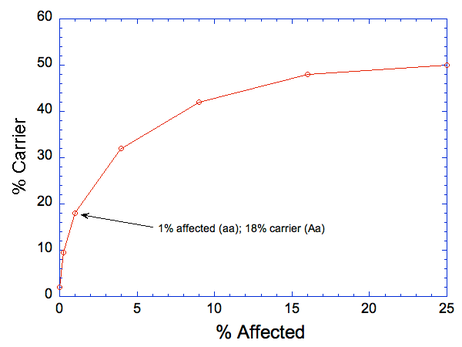
In the 1920’s, understanding of genetics was progressing from mysterious forces to the notion of “particles” of inheritance (we call them genes now) - actual, physical things that are passed from parent to offspring that somehow carry instructions sufficient to construct an entire animal and run it from the earliest embryo until death. It was becoming clear that there was some predictability in this, and geneticists were working furiously trying to understand how this would work.
This was not just academic. Plant and animal breeders realized that this information had the potential to revolutionize animal breeding and agriculture, so there was much happening that was specifically directed at breeding livestock and crops.
Sewall Wright was an evolutionary geneticist more interested in theory than cattle and corn breeding, but in addition to various academic positions he was employed by the US Department of Agriculture, which wanted to learn how to apply “modern” genetics to animal breeding. While he was at USDA, he wrote a short but seminal paper about inbreeding in animals called “Coefficients of Inbreeding and Relationship” (1921), in which he describes the derivation of his new coefficient of inbreeding (COI).
I think you will understand COI better if you know what problems Wright was trying to solve when he did this. It was well known that inbreeding produced two effects (Wright 1921):
“First, a decline in all elements of vigor, as weight, fertility, vitality, etc., and second, an increase in uniformity within the inbred stock, correlated with which is an increase in prepotency in outside crosses... The best explanation of the decrease in vigor is dependent on the view that Mendelian factors unfavorable to vigor in any respect are more frequently recessive than dominant, a situation which is the logical consequence of the two propositions that mutations are more likely to injure than improve the complex adjustments within an organzism and that injurious dominant mutations will be relatively promptly weeded out, leaving the recessive ones to accumulate, especially if they happen to be linked with favorable dominant factors. On this view, it may be readily shown that the decrease in vigor in starting inbreeding in a previously random-bred stock should be directly proportional to the increase in the percentage of homozygosity... As for the other effects of inbreeding, fixation of characters and increased prepotency, these are of course in direct proportion to the percentage of homozygosis. Thus, if we can calculate the percentage of homozygosis which would follow on the average from a given system of mating, we can at once form the most natural coefficient of inbreeding.”
Wright was thinking that since we know inbreeding has two consequences that matter to a breeder, one positive (uniformity and prepotency) and one negative (loss of vigor and fertility), it would be useful to be able to calculate the degree of inbreeding of an animal because it would make these effects more predictable. This was important because these two effects were at odds with each other; breeders could increase predictability and uniformity by inbreeding, but not without also having detrimental effects on an animal’s health and fertility. Breeders couldn’t just keep inbreeding and inbreeding to get better and better cattle; with each incremental improvement in uniformity and homozygosity, there would be a price to pay in health, vitality, and reproductive performance, traits that are collectively referred to as “fitness”. The short-term gain in consistency from inbreeding was paid for by a longer-term penalty in viability. For those in the business of agriculture, it was critically important that the balance between the positive and negative be controlled. Producing great cows today would be counterproductive if the ability to produce new stock in the future was diminished.
What Wright wanted was a way to predict the degree of homozygosity that would result from inbreeding, in which an allele originating from a single ancestor could be passed down on both sides of the pedigree and result in a descendant that is homozygous for that allele. Knowing that there are two possible alleles for each gene, and that which of the two is inherited was random, Wright could assume that for each generation the probability of inheriting one allele or the other was 50%. The sum of the probabilties for each generation would provide an estimate of homozygosity in a descendant.
“If an individual is inbred, his sire and dam are connected in the pedigree by lines of descent from a common ancestor or ancestors. The coefficient of inbreeding is obtained by a summation of coefficients for every line by which the parents are connected, each line tracing back from the sire to a common ancestor and thence forward to the dam, and passing through no individual more than once. The same ancestors may of course be involved in more than one line.” (Wright 1921)
It’s not necessary for you to understand all the fancy math in his paper, but you can probably imagine how complicated the computations could get for tracing all possible paths from multiple common ancestors to the individual of interest. You can do them by hand for a few generations, but past about 5 or so they are best left to a computer, and past about 10 the computer needs to be fast and efficient or the computing time can get quite long. This is probably why most COIs on breed websites are reported for 5-10 generations of pedigree data; beyond that, the task of computing them becomes onerous. But the number of generations used in the computation of COI profoundly affects the validity of the number you get (and you will always get a number, valid or not!), and it is critical for you to understand this and why it is a huge problem in interpreting data for dogs.
Complexity aside, the coefficient of inbreeding has become one of the most powerful tools a breeder can use, not only to predict the potential danger possible from a particular mating in terms of decreased fitness and increased incidence of genetic disease, but also to anticipate an animal’s possible value in the genetic improvement of the next generation. Used without consideration of both positive and negative effects, inbreeding is invariably destructive. But used carefully as part of a breeding plan that strategically balances its benefits and dangers, inbreeding can be a powerful tool.
Wright S, 1922. Coefficients of inbreeding and relationship. Am Nat 56: 330-338. (pdf)



